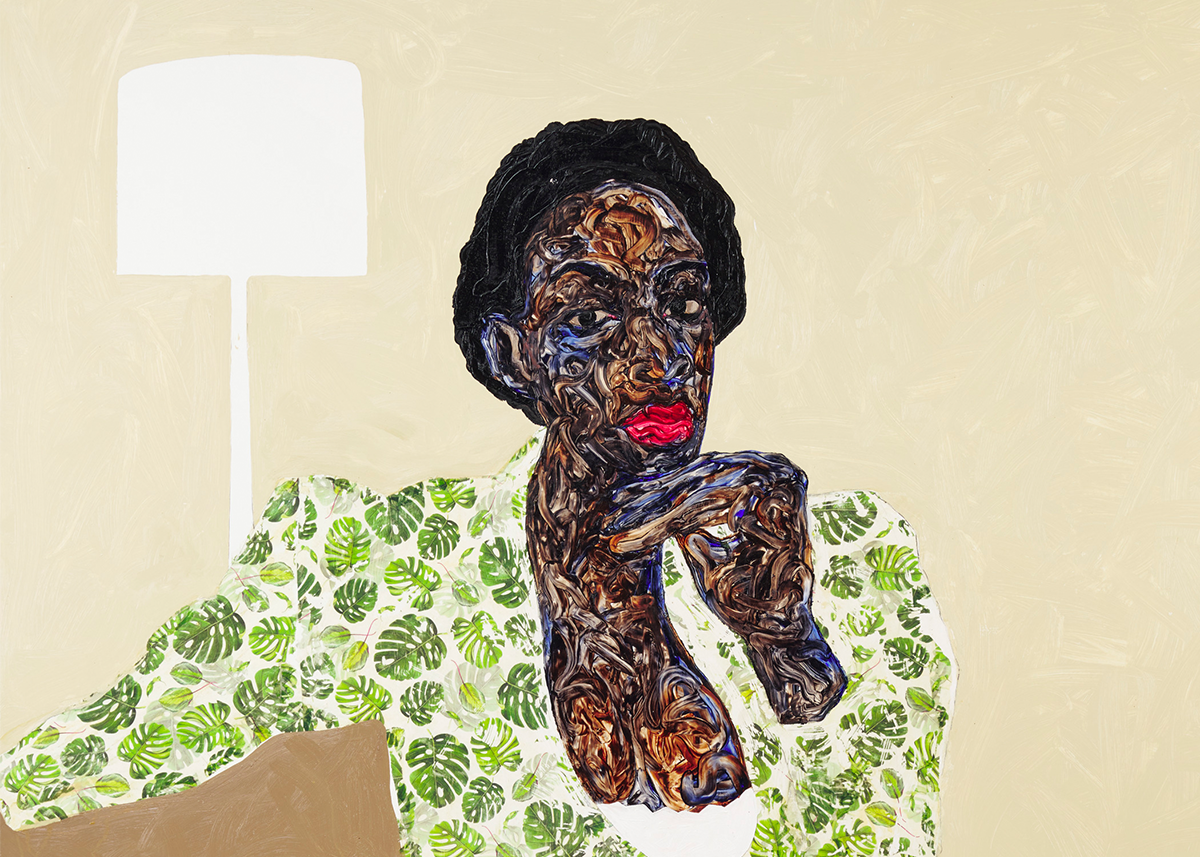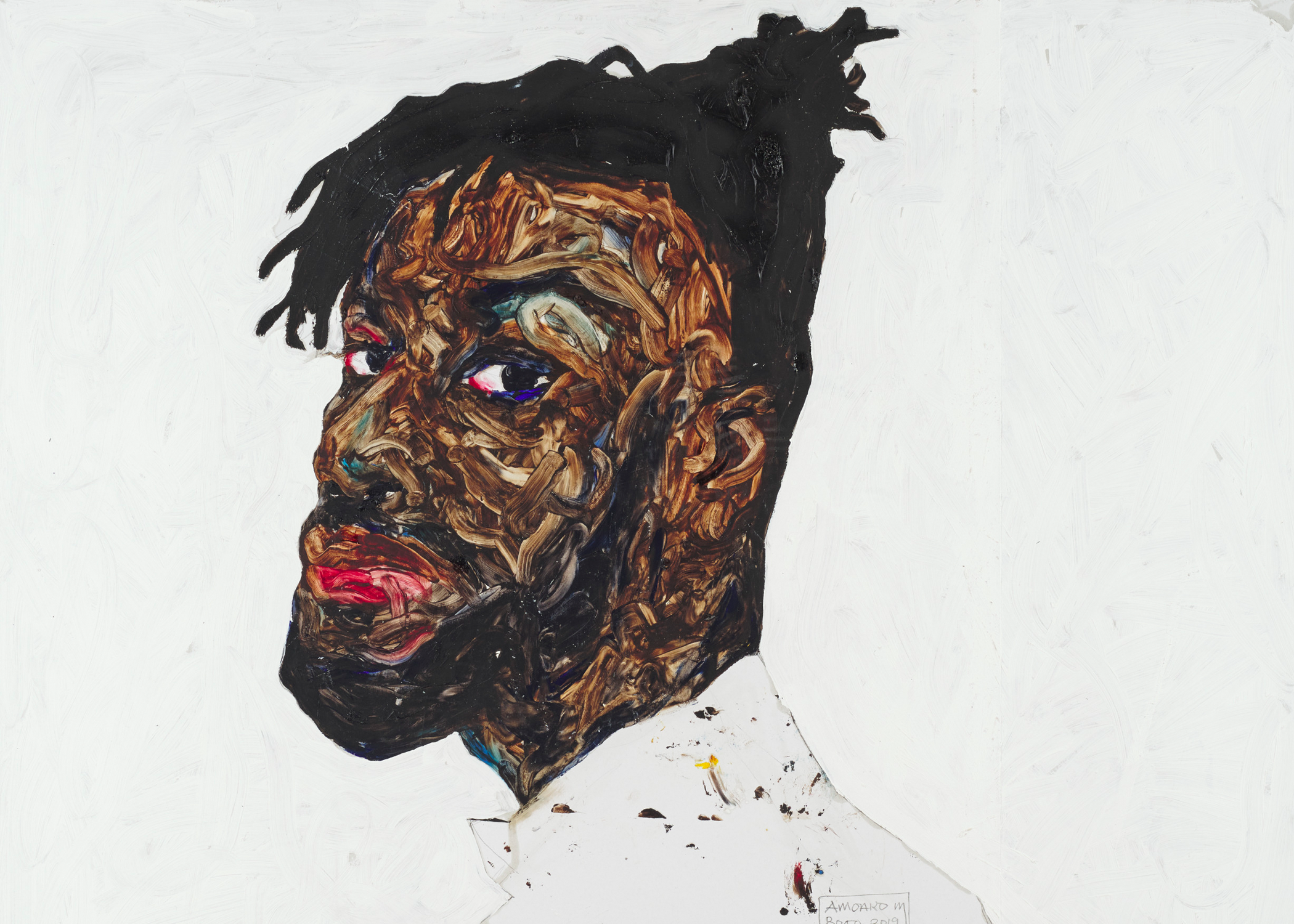
Denver Art Museum

Audio By Carbonatix
You might get a little chill down your spine when you enter the first floor of the Hamilton Building at the Denver Art Museum, which has just been filled with the large, vivid portraits of globally acclaimed figurative painter Amoako Boafo. It’s not a bad feeling: It’s the tingle of recognizing that you are witnessing the work of an artist of uncommon power, skill and presence.
Boafo was a promising ex-pat working in relative obscurity in Vienna when his work was noticed on Instagram in 2018 by none other than Kehinde Wiley, who painted Barack Obama’s presidential portrait. The art-world dominoes started tumbling, and soon Boafo was the toast of New York galleries and auction houses, collaborating with Dior and having his paintings literally shot into space. He also began a productive working relationship with Ghanaian-American curator Larry Ossei-Mensah, who collaborated with the artist on the current exhibition, which is Boafo’s first solo tour.
The collection, Soul of Black Folks, is an extensive display of his work from 2016 to 2022, and on display in Denver until February 19, 2024. It’s both a terrific introduction to Boafo’s work as a whole and a journey through his development.
“The show has also kind of become this diary of six years in his life,” says Ossei-Mensah. “So we thought it would be appropriate for those who haven’t seen that many of his works, or you’re seeing the works for the first time, that you engage him fully formed – as an artist who is very clear about the practice, clear about the intentions, clear about what they want you to experience.”

Curator Larry Ossei-Mensah with “Ghana Must Go,” at the Denver Art Museum.
John Flathman
Fascinated by portraiture from a young age, Boafo grew up in the Accra region of Ghana, near the burial place of W.E.B. Du Bois, from whose 1903 collection of essays the show takes its title. Du Bois is one of several Black literary influences (alongside Frantz Fanon, Taiye Selasi and others) referenced in the exhibit that take the viewer outside of the gallery walls to address the larger context of being an African artist and person. Like Du Bois, a large part of Boafo’s project is using his lyrical talents to elevate the identity of himself and his community in a world that is often hostile to them.
“The primary idea of my practice is representing, documenting, celebrating and showing new ways to approach Blackness,” elaborates Boafo. Similar to how “a writer expresses themselves with words, I express myself by painting a picture.” Accordingly, his subjects are from the African diaspora, both Ghanaians like himself, as well as those from its wider reaches. A few in the exhibit, such as Beyoncé and Jay-Z in the gorgeous double portrait “Sunflower Bee Shirt,” are megastars, reflecting his own ascent toward the upper peaks of the art world. Mostly, they are everyday people and friends.
As the title of his show would suggest, Boafo is truly gifted at capturing the spirit of his subjects, whether that reflects ecstatic friendship in “Libby and D-Lee” or deep introspection in his own self-portraits. Also important to the show’s experience is how Boafo highlights the Black gaze. Figures found in “Black Hat” and “Green Clutch” are the subject of our interest, but they look back, too – this is their space.

“Fuck You Mean Tho,” by Amoako Boafo.
Denver Art Museum
The representation of his subjects’ skin color is not only significant thematically; it’s also where Boafo displays one of his most distinctive techniques: He fingerpaints. Sinking his digits directly into the paint, he mixes and applies colors for the flesh tones completely by hand, almost as if he were sculpting. Placed against monochromatic backgrounds, typically off-white shades grading into pinks and yellows (his favorite color), the faces and hands of the subjects come alive with texture. The unconventional “brush strokes” are somewhat like Impressionism: The closer you get to the canvas, the more there is to look at.
“The process for him, he’s an incredible draftsman,” explains Ossei-Mensah of the approach. “For him, once the drawing is done, the painting is done, and the actual painting part is where he has fun. That’s where you have the improvisation. I invite you to really look closely at the finger strokes. Are they long strokes? Are they short strokes? … Because a lot of that will give an insight into his mood on that particular day. He may have been listening to, like, Black Sheriff, who’s a young rapper from Ghana who’s energetic. And so that energy may transfer onto what you see on the paper or the canvas.”

“White on White,” by Amoako Boafo.
Denver Art Museum
The DAM staff, led by Vicki and Kent Logan Curator of Modern and Contemporary Art Rory Padeken, has arranged the show with its usual style. Features such as a video installation of Boafo at work with close inspection of his technique and a well-stocked reading room full of his literary and visual influences (and comfy chairs) aren’t afterthoughts; they’re central to the experience. The curators hope it will encourage visitors to relax, enjoy the art and absorb its atmosphere.
“This, for us, is a way of extending the engagement of the exhibition,” says Ossei-Mensah. “We want you stay for a little while. We want you to hang out.”
Amoako Boafu: Soul of Black Folks, on display until February 19, 2024, Denver Art Museum, 100 West 14th Avenue Parkway. Tickets are available at denverartmuseum.org.